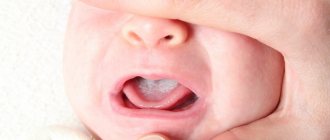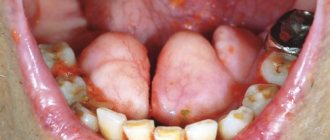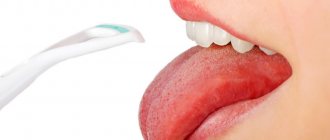The unconscious state always contains a certain danger. A person who has lost consciousness does not feel anything, his pain threshold is lowered, he does not understand what is happening to him, and is not able to help himself. Therefore, the victim needs medical attention.
An unconscious state is characterized by a serious threat of choking on vomit, blood, mucus and other masses that rush out of the digestive tract, simultaneously clogging the airways. However, more often in practice, another problem is observed, which is considered more dangerous than the movement of vomit, this is the displacement of the root of the tongue.
What it is?
Relaxation of the muscles of the lower jaw and the root muscles of the tongue while a person is unconscious will inevitably lead to the movement of the tongue from its usual position to the larynx. This phenomenon is popularly and medically called “tongue retraction.” It is characterized by a displacement of the tongue muscles towards the wall of the larynx, which leads to a cessation of air flow into the lungs, resulting in suffocation, in other words, asphyxia.
Retraction of the root of the tongue is primarily dangerous because, if the necessary assistance is not provided, the person will suffocate due to lack of air. Asphyxia that develops as a result of tongue displacement leads to a decrease in the level of oxygen in the tissues and an increase in the level of carbon dioxide in the blood. As a result, a person dies within 10 minutes from suffocation.
Causes of tongue retraction
The main reason for the development of this pathological condition is relaxation of the root of the tongue and the muscles of the lower jaw, which partly control the position of the tongue in the oral cavity. So, for example, if a victim has a broken lower jaw on both sides, then the likelihood of the tongue root being displaced is quite high.
However, in medical practice, such a cause of tongue displacement as a broken jaw is rare. Much more often, this phenomenon occurs during a long coma, during which many muscles, including the tongue, atrophy. A patient's tongue may become retracted after anesthesia is administered before surgery. Pathology is also observed in victims of accidents and other accidents, which entail severe pain shock.
Signs of an abnormal (shortened) frenulum
A normal frenulum of the tongue in a newborn should be about 8 mm long. By the age of five, its length can increase to 17-18 mm.
Signs of a lack of frenulum length in infants:
- feeding lasts longer than usual and occurs with short stops;
- the baby is capricious when feeding;
- the child arches, throws back his head;
- underweight;
- the baby bites the breast and “clicks” when feeding;
- The baby may refuse to breastfeed.
Signs of a short frenulum of the tongue in older children and adult patients:
- malocclusion;
- frequently recurring periodontitis;
- problematic fixation of prostheses;
- difficulties in pronouncing many sounds;
- periodontal diseases.
A shortened frenulum is also indicated by:
- lower incisors directed inward;
- bifurcation of the tip of the tongue and its deepening when trying to stretch it;
- inability to reach the tip of the tongue to the sky or lick your lips;
- the tongue is uneven, its lower end is pressed, and its rear end is raised;
- have difficulty swallowing solid food;
- heart-shaped tongue in an elevated position;
- the tongue bends as it moves forward.
If a shortened frenulum of the tongue is detected, its correction is required. And the sooner this is done, the better.
There are different types of tongue frenulum anomalies:
- thin transparent (because of it the tongue functions poorly, but the child does not feel discomfort);
- translucent, with a bifurcating ending when the tongue moves;
- thick, attached to the lower palate and noticeably limiting its mobility;
- short, fused with the muscles of the tongue;
- unexpressed, difficult to notice due to complete fusion with the muscles (the tongue moves with difficulty, swallowing food is difficult and speech disorders are observed).
In each case, the doctor determines the degree of shortening of the frenulum and the method of treating the anomaly.
Epilepsy as one of the reasons
There are still many myths about tongue swallowing during an epileptic seizure. Some people ignorant of medicine try to open the mouth of an epileptic during a seizure with a spoon, pens, or their own fingers, simultaneously fixing the unclenched jaws with a stick or other objects. It should be noted here that such measures not only will not help the patient, but can also break his teeth and damage the oral mucosa.
The only thing a passerby can do to help a person suffering from an epileptic seizure is to try to make the space around him as safe as possible: remove hot and sharp objects to prevent head injury, put soft clothes underneath. During an attack, a person may bite his tongue, but he will never swallow it for another reason: during an epileptic seizure, all the muscles of the body are extremely tense and hypertonic.
However, tongue retraction can actually happen, not during an attack, but after it, when the muscles, on the contrary, are in a state of hypotonicity. In this case, relaxation of the root of the tongue can cause it to move from its usual position and subsequent blockage of the larynx.
Tongue cramp - stuttering
Stuttering is convulsive movements of the laryngeal and articulatory muscles that occur at the beginning or middle of speech. A person is forced to linger on some sound or group of sounds. Symptoms are similar to tonic and clonic seizures. In the first case, the patient cannot move from the sound stop to articulate the next sound. In the second case, a person who stutters repeatedly forms words, syllables and sounds. The disease has four stages, ranging from rare attacks to serious personality problems.
Stuttering of neurotic origin can appear in a healthy person as a result of neurosis or stress. It often occurs in children with hereditary or acquired diseases of the nervous system. The causes of the disease are provoking and predisposing.
Provoking factors include:
- sudden fear or fright;
- imitation;
- accelerated speech;
- multilingual families
Predisposing reasons:
- heredity;
- birth and intrauterine injuries;
- infectious diseases due to fatigue and nervous exhaustion
Conditions that contribute to the appearance of speech disorders include:
- insufficient emotional development;
- violation of the sense of rhythm;
- increased reactivity in relationships with others;
- hidden mental disorders
When stuttering, the breathing process is disrupted. A large amount of air is consumed when inhaling and exhaling. The closure in the glottis prevents the pronunciation of sounds, while the larynx moves sharply and quickly down, up and forward. A curvature of the nasal septum and hypertrophy of the conchae are often observed. During an attack, a person may throw his head back, clench his fists, close his eyes, or stomp his feet. Stuttering, to one degree or another, leads to mental disorders and fear of pronouncing difficult sounds. In some cases this leads to muteness. The child avoids speech situations, which narrows his social circle and affects his overall development. He becomes cautious, suspicious, begins to feel a big difference between himself and his peers and considers himself flawed and inferior. This in turn worsens the symptoms of the disease.
To diagnose a speech disorder, the following symptoms must be present:
- speech rhythm disturbance;
- hesitation;
- an attempt to replace words with grimaces and tics
The success of treatment largely depends on correct and timely diagnosis. Correction of speech disorders is carried out in classes with a speech therapist. Stuttering of neurotic origin in young children is successfully treated in speech therapy groups using play psychotherapy and rhythmics. Family therapy is also of great importance when distraction, suggestion and relaxation are used. The child is taught to speak in rhythm with the movements of his fingers and in a chant. Since the disease occurs as a result of organic lesions of the brain, antispasmodics and tranquilizers in minimal doses are used as drug treatment. Additionally, treatment includes massage and physiotherapy. In seventy percent of cases in the treatment of stuttering in children, the prognosis is favorable.
Preventive measures can be divided into two groups. One is aimed at maintaining and strengthening children's health, the second at activities to organize speech development. For this, it is important to have good nutrition, adherence to a daily routine, and the absence of overexertion and stress. Speech development should be aimed at broadening one’s horizons about the world around us, objects and phenomena. It is necessary to teach the child to speak slowly and smoothly, to consistently express his thoughts. New information needs to be communicated to children in doses and gradually.
Appearance of pathology
As mentioned, the main symptom and at the same time the most negative consequence of tongue displacement is choking. A person cannot breathe in air because the path to the lungs is blocked. He also cannot exhale air filled with carbon dioxide, as a result of which blood circulation in the body is disrupted. This leads to a change in the patient’s complexion; it acquires a bluish tint. The longer a person does not receive the required amount of oxygen, the further the so-called cyanosis spreads: the upper part of the chest becomes blue.
A person who has had a recessed tongue begins to sweat profusely, and the veins in his neck swell and increase in size. He begins to make reflexive involuntary movements with his arms and legs, rushing from side to side due to the inability to take a full breath. The breathing itself is hoarse, arrhythmic (due to excessive tension of the intercostal muscles and neck muscles).
How can I help?
First of all, the person whose tongue has shifted needs to be placed in a horizontal position. After performing this manipulation, it is necessary to tilt his head back: the left hand is placed on the victim’s forehead, and the right hand at this time raises the neck, and a retainer (pillow, bolster) is placed under it. After throwing back the head, you need to extend his lower jaw. To do this, its right and left corners are taken with both hands, shifted down and then raised forward. If breathing is restored, the person should be turned on his side to prevent relapse.
If these measures do not help to restore the patency of the airways when the tongue is retracted, then you need to move on to a proven and guaranteed method of ending the state of suffocation by getting rid of the causative factor. In this case, this is removing the tongue from the oral cavity and fixing it outside. Manipulation involves pulling the tongue out of the mouth using cloth-wrapped fingers, tweezers, forceps and, in fact, any instrument capable of capturing and holding the tongue. The next step is to secure it at the chin with an adhesive plaster or bandage.
If the displacement of the root of the tongue occurs due to a fracture of the lower jaw, then assistance should immediately begin with removing it from the mouth and subsequent fixation at the chin. Subsequent manipulations, such as matching and connecting fragments of a broken jaw, can only be provided in a specialized institution. Also, in ambulances called, doctors can provide professional assistance with tongue retraction, as they have devices for artificial ventilation of the lungs. A special air duct is placed between the root of the tongue and the wall of the pharynx, providing the lungs with air flow.
Tongue cramp causes
The tongue is involved in many actions:
- support of taste functions;
- chewing;
- swallowing;
- sucking;
- formation of noise and sound.
Lingual cramps are damage to the hypoglossal nerve. They differ in etiology and mechanisms of origin. They can be tonic, clonic or mixed. Since the tongue is in a closed cavity, its spasms are not as noticeable as, for example, facial ones. The only exception is when it comes out of the mouth and throws out saliva. You can trace the spasm if you watch carefully and know the mechanism of pronouncing letters.
The cause of seizures may be inflammatory processes in the oral cavity or as a result of neurological manifestations of the lingual nerve, as in hysteria, epilepsy or chorea.
Tongue muscle spasm - glossospasm
With glossospasm, equal tension is observed on both halves of the tongue. Hysteria is characterized by the manifestation of a half spasm, which is called hemiglossospasm. The spasm may manifest itself as a tic, like sticking out the tongue when trying to remove non-existent lumps of food from the gums. The symptom of the eye and tongue with chorea is that a person cannot hold his tongue out for a long time with his eyes closed. After some time, violent movements of the tongue occur, and the eyes open.
The prognosis for such diseases is not always favorable.
What not to do
All manipulations regarding moving the victim in space and changing the position of his head and neck are contraindicated if the person is suspected of having a cervical fracture. Any careless movement towards the victim can harm him even more. In this case, changing the position of the jaw forward and down will suffice.
It is also worth noting that some citizens have a myth firmly entrenched in their heads that it is necessary to remove the tongue and pin it with a pin or needle to the victim’s collar or cheek. Doing this is absolutely contraindicated and pointless. Moreover, first aid for tongue retraction should not be provided by such barbaric methods. To fix the tongue, a regular adhesive plaster attached to the chin will do. Moreover, fixation itself is necessary in extreme cases; changing the position of the head and neck is usually enough.
Prevention of tongue root displacement
When a person loses consciousness, the muscles of his body relax, including the tongue, which can fall to the back of the larynx, causing an attack of suffocation. This does not happen so often with ordinary fainting, but a number of measures should still be taken, the purpose of which is to prevent tongue retraction. Its main principle is to tilt the victim’s head back by raising the neck and placing a cushion under it. You can also secure the tongue with an adhesive tape or bandage passing through the bottom of the lower jaw and securing it around the forehead. If the jaw is broken, then you need to act differently: you need to put the person on his stomach, face down.
Plastic frenulum of the tongue
The operation can be performed using two methods:
- traditional (using a scalpel);
- using a surgical laser.
The procedure is always performed on an outpatient basis. During the operation, local anesthesia is used.
With the traditional surgical option of correcting the frenulum of the tongue, excision of old scars is required if the frenulum has already been trimmed in infancy. A submucosal flap is also formed and the attachment site of the lingual frenulum is transferred. After cutting, special self-absorbing sutures are applied.
During the operation, it is necessary to constantly monitor the condition of the mouths of the ducts of the sublingual and submandibular salivary glands. This is necessary to avoid damage.
Laser treatment has significant advantages over traditional dental surgery:
- accuracy,
- bacteriostatic effect,
- no bleeding,
- no stitches required,
- more comfortable conditions for the patient.
Laser equipment operates in non-contact mode. The dentist directs the sapphire tip of a laser device to the frenulum, which forms a well-focused beam. This laser beam effectively “dissolves” tissue in the desired location. The operation lasts no more than 5 minutes.
Conclusion
Tongue retraction is a rather dangerous phenomenon, which consists in displacement of its root and clogging of the airways. A similar condition occurs when the muscles of the body, including the tongue, relax during unconsciousness, coma and anesthesia, as well as during fractures of the lower jaw.
When the tongue moves, the person begins to choke, the veins in his neck swell, his breathing becomes hoarse, and his face gradually turns blue. You can help a person by tilting his head back and changing the position of his jaw. It also helps to fix the tongue outside the mouth by attaching it to the chin, but in no case with pins or needles.











